1997 BUICK CENTURY ESP
[x] Cancel search: ESPPage 6 of 406
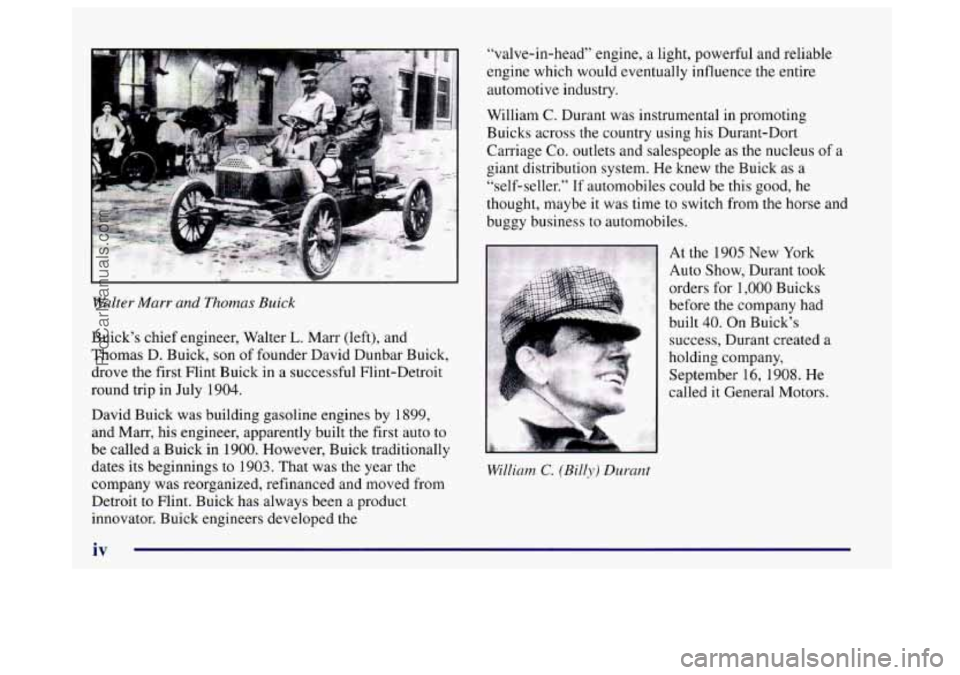
Walter Marr and Thomas Buick
Buick’s chief engineer, Walter L. Marr (left), and
Thomas D. Buick, son of founder David Dunbar Buick,
drove the first Flint Buick in a successful Flint-Detroit
round trip in July 1904.
David Buick was building gasoline engines by 1899,
and Marr, his engineer, apparently built the first auto
to
be called a Buick in 1900. However, Buick traditionally
dates its beginnings to
1903. That was the year the
company was reorganized, refinanced and moved from
Detroit to Flint. Buick has always been a product
innovator. Buick engineers developed the “valve-in-head” engine,
a light, powerful and reliable
engine which would eventually influence the entire
automotive industry.
William
C. Durant was instrumental in promoting
Buicks across the country using his Durant-Dort
Carriage
Co. outlets and salespeople as the nucleus of a
giant distribution system. He knew the Buick as a
“self-seller.” If automobiles could be this good, he
thought, maybe
it was time to switch from the horse and
buggy business
to automobiles.
William C. (Billy) Durant
At the 1905 New York
Auto Show, Durant
took
orders for 1,000 Buicks
before the company had
built
40. On Buick’s
success, Durant created a
holding company,
September
16, 1908. He
called it General Motors.
iv
ProCarManuals.com
Page 23 of 406

or the safety belts!
With safety belts, you slow down as the vehicle does.
You get more time to stop. You stop over more distance,
and your strongest bones take the forces. That’s why
safety belts make such good sense.
Here Are Questions Many People Ask
About Safety Belts
-- and the Answers
&= Won’t I be trapped in the vehicle after an
accident if I’m wearing a safety belt?
A: You could be -- whether you’re wearing a safety
belt or
not. But you can unbuckle a safety belt,
even
if you’re upside down. And your chance of
being conscious during and after an accident,
so
you can unbuckle and get out, is much greater if
you are belted.
@ If my vehicle has air bags, why should I have to
wear safety belts?
A: Air bags are in many vehicles today and will be
in most
of them in the future. But they are
supplemental systems only;
so they work with
safety belts -- not instead of them. Every air bag
system ever offered for sale has required the use
of safety belts. Even if you’re in
a vehicle that has
air bags, you still have to buckle up to get the most
protection. That’s true not only in frontal collisions,
but especially in side and other collisions.
1-9
ProCarManuals.com
Page 80 of 406
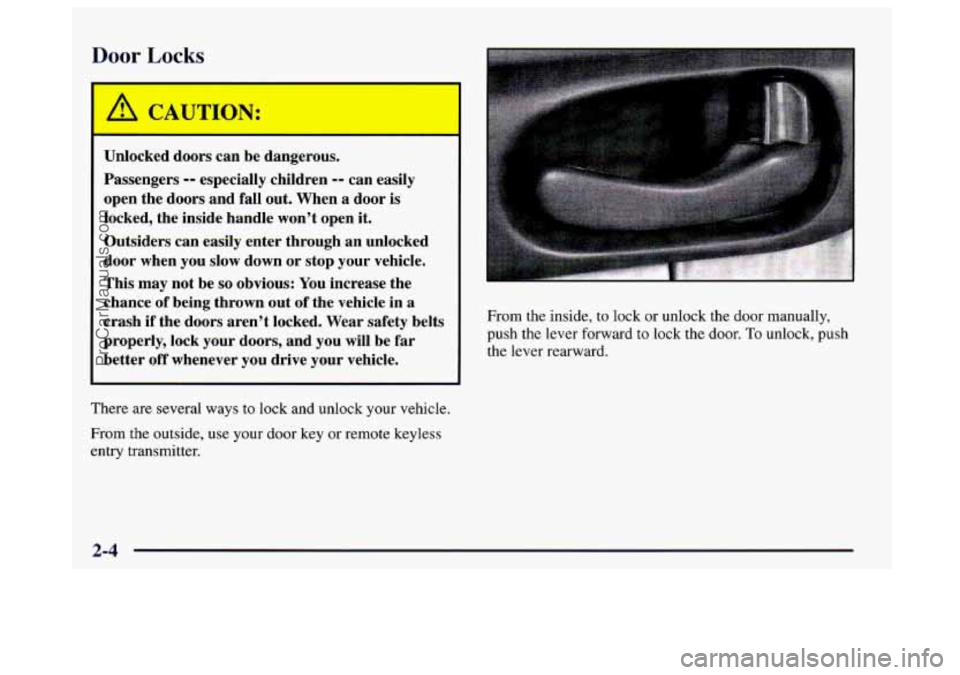
Door Locks
Unlocked doors can be dangerous.
Passengers
-- especially children -- can easily
open the doors and fall out. When a door is
locked, the inside handle won’t open it.
Outsiders can easily enter through an unlocked
door when you slow down or stop your vehicle.
This may not be
so obvious: You increase the
chance of being thrown out
of the vehicle in a
crash
if the doors aren’t locked. Wear safety belts
properly, lock your doors, and you will be far
better
off whenever you drive your vehicle.
There are several ways to lock and unlock your vehicle.
From the outside, use your door key
or remote keyless
entry transmitter. From the
inside, to lock or unlock the door manually,
push the lever forward to
lock the door. To unlock, push
the lever rearward.
2-4
ProCarManuals.com
Page 87 of 406

Security Feedback
Security Feedback provides audible and/or visible
feedback that a remote keyless entry lock or unlock
command has been received and executed. Your
vehicle’s ignition must be off for this feature to work.
You may select one of four operating modes for
reception
of a lock command. You may also select one
of four operating modes for reception of an unlock
command. The selection and programming of the lock
and unlock operating modes are independent of each
other. The following modes are available for either lock
or unlock verification:
Mode
1 : No Verification
Mode
2: Horn Chirp only
Mode
3: Headlamp Flash only
Mode
4: Horn Chirp and Headlamp Flash
The operating mode
of the Security Feedback lock
function will be changed when you perform the following
sequence with your vehicle’s doors closed and the ignition
key in
RUN:
Press and hold the power’door lock switch. While
holding the door lock switch, press and release the
remote keyless entry
(RKE) transmitter lock switch.
This will initialize the customization mode. While in the customization
mode, the chime will sound the number
of chimes corresponding to the current Security
Feedback lock mode. Each additional press of the
RKE
transmitter lock switch will cause your vehicle to
advance the lock mode by one, starting from the current
Security Feedback lock mode. If cycled beyond lock
Mode
4, the vehicle will enter lock Mode 1. During this
procedure, the chime will sound the number
of chimes
corresponding
to the current lock mode, providing you
with feedback. When the door lock switch is released,
the vehicle will remain in the most recent lock mode.
The operating mode
of the Security Feedback unlock
function will
be changed when you perform the
following sequence with your vehicle’s doors closed and
the ignition key in
RUN:
Press and hold the power door unlock switch. While
holding the door unlock switch, press and release the
RKE
transmitter unlock switch. This will initialize the
customization mode. While in the customization mode, the
chime will sound the number
of chimes corresponding to
the current unlock mode. Each additional press of the
RKE transmitter unlock switch will cause your vehicle to
advance the unlock mode by one, starting from the current
unlock mode. If cycled beyond unlock Mode
4, the vehicle
will enter unlock Mode
1. During this procedure, the
chime will sound the number
of chimes corresponding to
2-11
ProCarManuals.com
Page 91 of 406
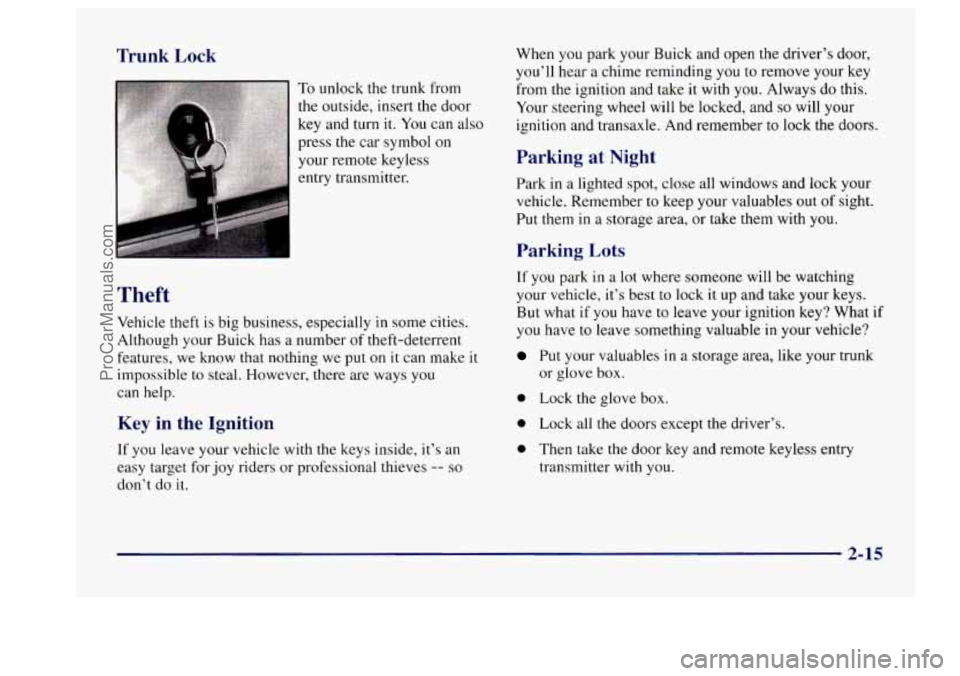
Trunk Lock
To unlock the trunk from
the outside, insert the door
key and turn
it. You can also
press the car symbol on
your remote keyless
entry transmitter.
Theft
Vehicle theft is big business, especially in some cities.
Although your Buick has a number
of theft-deterrent
features, we know that nothing we put on it can make it
impossible to steal. However, there are ways
you
can help.
Key in the Ignition
If you leave your vehicle with the keys inside, it’s an
easy target for joy riders or professional thieves
-- so
don’t do it. When
you park your Buick and open the driver’s door,
you’ll hear
a chime reminding you to remove your key
from the ignition and take it with you. Always do this.
Your steering wheel will be locked, and so will your
ignition and transaxle. And remember to lock the doors.
Parking at Night
Park in a lighted spot, close all windows and lock your
vehicle. Remember to keep your valuables out of sight.
Put them
in a storage area, or take them with you.
Parking Lots
If you park in a lot where someone will be watching
your vehicle, it’s best
to lock it up and take your keys.
But what if
you have to leave your ignition key? What if
you have to leave something valuable in your vehicle?
Put your valuables in a storage area, like your trunk
or glove
box.
0 Lock the glove box.
0 Lock all the doors except the driver’s.
0 Then take the door key and remote keyless entry
transmitter with
you.
2-15
ProCarManuals.com
Page 118 of 406
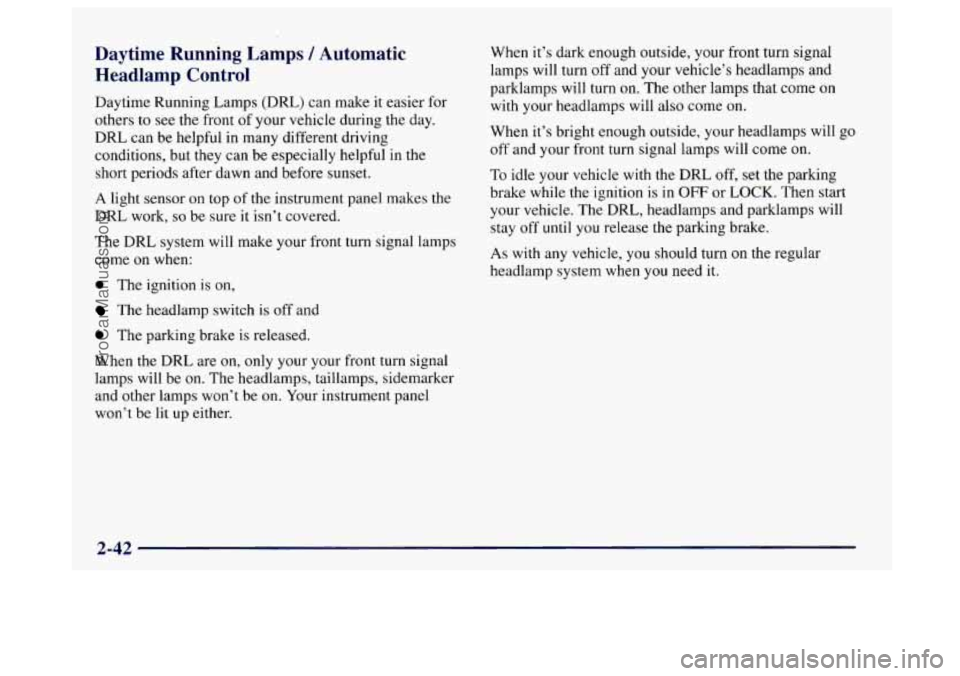
Daytime Running Lamps / Automatic
Headlamp Control
Daytime Running Lamps (DRL) can make it easier for
others to see the front
of your vehicle during the day.
DRL can be helpful
in many different driving
conditions, but
they can be especially helpful in the
short periods after dawn and before sunset.
A light sensor on top of the instrument panel makes the
DRL work,
so be sure it isn’t covered.
The DRL system
will make your front turn signal lamps
come on when:
0 The ignition is on,
The headlamp switch is off and
0 The parking brake is released.
When the DRL are on, only your your front turn signal
lamps will be on. The headlamps, taillamps, sidemarker
and other lamps won’t be
on. Your instrument panel
won’t be lit up either. When it’s
dark enough outside, your front turn signal
lamps will turn off and your vehicle’s headlamps and
parklamps will turn on. The other lamps that come on
with your headlamps will also come on.
When it’s bright enough outside, your headlamps will go
off and your front turn signal lamps will come on.
To idle your vehicle with the DRL off, set the parking
brake while the ignition is in
OFF or LOCK. Then start
your vehicle. The DRL, headlamps and parklamps will
stay off
until you release the parking brake.
As with any vehicle, you should turn on the regular
headlamp system when you need
it.
2-42
ProCarManuals.com
Page 178 of 406

AM-FM: Press this button to choose AM, FM1 or FM2.
If a cassette tape or compact disc is playing, press this
button to stop it and the radio will play.
SRCE: Press this button to
change to the cassette tape,
compact disc function or
return
to playing the radio.
MUTE: Press this button to silence the audio system.
Press it again to turn on the sound.
VOL: Press the up or down arrow to increase or
decrease volume.
Understanding Radio Reception
FM Stereo
FM stereo will give you the best sound, but FM signals
will reach only about 10 to
40 miles (16 to 65 km). Tall
buildings or hills can interfere with FM signals, causing
the sound to come and go.
AM
The range for most AM stations is greater than for FM,
especially
at night. The longer range, however, can
cause stations to interfere with each other.
AM can pick
up noise from things like storms and power lines. Try
reducing the treble to reduce this noise
if you ever get it.
Tips About Your Audio System
Hearing damage from loud noise is almost undetectable
until
it is too late. Your hearing can adapt to higher
volumes
of sound. Sound that seems normal can be loud
and harmful to your hearing. Take precautions by
adjusting
the volume control on your radio to a safe
sound level before your hearing adapts to
it.
3-34
ProCarManuals.com
Page 191 of 406
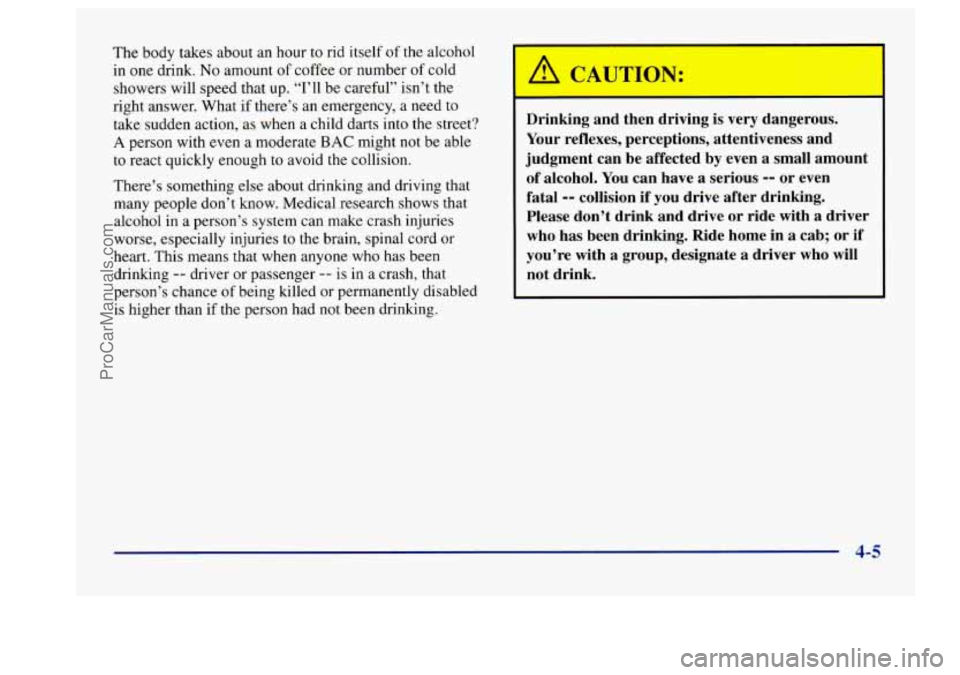
The body takes about an hour to rid itself of the alcohol
in one drink.
No amount of coffee or number of cold
showers will speed that up. “1’11 be careful” isn’t the
right answer. What if there’s an emergency, a need
to
take sudden action, as when a child darts into the street?
A person with even a moderate BAC might not be able
to react quickly enough to avoid the collision.
There’s something else about drinking and driving that
many people don’t know. Medical research shows that
alcohol in
a person’s system can make crash injuries
worse, especially injuries to the brain, spinal cord or
heart.
This means that when anyone who has been
drinking
-- driver or passenger -- is in a crash, that
person’s chance
of being killed or permanently disabled
is higher than if the person had not been drinking.
A CAUTION:
DriLing and then driving is very dangerous.
Your reflexes, perceptions, attentiveness and
judgment can be affected by even
a small amount
of alcohol. You can have a serious
-- or even
fatal
-- collision if you drive after drinking.
Please don’t drink and drive or ride with
a driver
who has been drinking. Ride home in a cab; or if
you’re with a group, designate
a driver who will
not drink.
4-5
ProCarManuals.com